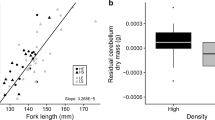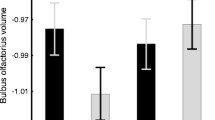Abstract
In this study, we contrast brain morphology from hatchery and wild reared stocks to examine the hypothesis that in salmonid fishes, captive rearing produces changes in brain development. Using rainbow trout, Oncorhynchus mykiss, as a model, we measured eight regions of the salmonid brain to examine differences between wild and hatchery reared fish. We find using multiple analysis of covariance (MANCOVA), analysis of covariance (ANCOVA) and discriminant function analysis (DFA) that the brains of hatchery reared fish are relatively smaller in several critical measures than their wild counterparts. Our work may suggest a mechanistic basis for the observed vulnerability of hatchery fish to predation and their general low survival upon release into the wild. Our results are the first to highlight the effects of hatchery rearing on changes in brain development inbreak fishes.
Similar content being viewed by others
References cited
Barngrover, B.G. 1990. Rainbow trout strains in California state hatcheries. California Fish and Game 76: 91-102.
Berejikian, B.A., E.P. Tezak, S.L. Schroder, C.M. Knudsen & J.J. Hard. 1997. Reproductive behavioral interactions between wild and captively reared coho salmon (Oncorhynchus kisutch). ICES J. Mar. Sci. 54: 1040-1050.
Brandstatter, R. & K. Kortschal. 1990. Brain growth patterns in four European cyprinid fish species (Cyprinidae, Teleostei), roach (Rutilus rutilus), bream (Abramis brama), common carp (Cyprinus carpio) and saber carp (Pelecus cultratus). Brain Behav. Evol. 35: 195-211.
Brannon, E.L. 1993. The perpetual oversight of hatchery programs. Fish. Res. (Amst.) 18: 19-27.
Ebinger, P. & M. Rohrs. 1995. Domestication and plasticity of brain organization in mallards (Anas platyrhynchos). J. Brain Res. 36: 219-228.
Fleming, I.A. & M.R. Gross. 1993. Breeding success of hatchery and wild coho salmon (Oncorhynchus kisutch) in competition. Ecol. App. 3: 230-245.
Fleming, I.A. & S. Einum. 1997. Experimental tests of genetic divergence of farmed from wild Atlantic salmon due to domestication. ICES J. Mar. Sci. 54: 1051-1063.
Fleming, I.A., A. Lamberg & B. Jonsson. 1997. Effects of early experience on the reproductive performance of Atlantic salmon. Behav. Evol. 8: 470-480.
Gross, M.R. 1998. One species with two biologies: Atlantic salmon (Salmo salar) in the wild and in aquaculture. Can. J. Fish. Aquat. Sci. 55(suppl.): 131-144.
Hard J.J., B.A. Berejikian, E.P. Tezak, S.L. Schroder, C.M. Knudsen & L.T. Parker. 2000. Evidence for morphometric differentiation of wild and captively reared adult coho salmon: a geometric analysis. Env. Biol. Fish. 58: 61-73.
Healy, S. & T. Guilford. 1990. Olfactory bulb size and nocturnality in birds. Evolution 44: 339-346.
Huber, R. & M.K. Rylander. 1992. Brain morphology and turbidity preference in Notropis and related genera (Cyprinidae, Teleosteii). Env. Biol. Fish. 33: 153-165.
Huber, R., M.J. Staaden, L.S. Kaufman & K.F. Liem. 1997. Microhabitat use, trophic patterns and the evolution of brain structures in African cichlids. Brain Behav. Evol. 50: 167-182.
Ishikawa, Y., M. Yoshimoto, N. Yamamoto & H. Ito. 1999. Different brain morphologies from different genotypes in a single teleost species, the medaka (Oryzias latipes). Brain Behav. Evol. 53: 2-9.
Jacobs, B.L., H. VanPraag & F.H. Gage. 2000. Depression and the birth and death of brain cells. Amer. Sci. 88: 340-345.
Jonsson, B. 1997. Review of ecological and behavioral interactions between cultured and wild Atlantic salmon. ICES J. Mar. Sci. 54: 1031-1039.
Jonsson, B., N. Jonsson & L.P. Hansen. 1991. Difference in life history and migratory behavior between wild and hatchery reared Atlantic salmon in nature. Aquaculture 98: 69-78.
Kempermann, G., H.G. Kuhn & F.H. Gage. 1997a. Genetic influence on neurogenesis in the dentate gyrus of adult mice. Proc. Nat. Acad. Sci. 94: 10409-10414.
Kempermann, G., H.G. Kuhn & F.H. Gage. 1997b. More hippocampal neurons in adult mice living in an enriched environment. Nature 386: 493-495.
Kempermann, G. & F.H. Gage. 1999. New nerve cells for the adult brain. Sci. Amer. May 48-53.
Kotrschal, K. & M. Palzenberger. 1992. Neuroecology of cyprinids: comparative qualitative histology reveals diverse brain patterns. Env. Biol. Fish. 33: 135-152.
Kotrschal, K., M.J. VanStaaden & R. Huber. 1998. Fish brains: evolution and environmental relationships. Rev. Fish. Biol. Fisheries 8: 373-408.
Masai, H., K. Takatsuji & Y. Sato. 1982. Morphological variability of the brains under domestication from the crucian carp to the goldfish. Z. Zool. Syst. Evol.-Forsch. 20: 112-118.
Moyle, P.B. & J.J. Cech. 2000. Fishes: an introduction to ichthyology, 4th edn. Prentice Hall, Upper Saddle River. 612 pp.
Petersson, E. & T. Jarvi. 1997. Reproductive behavior of sea trout (Salmo trutta)-the consequences of sea-ranching. Behavior 134: 1-22.
Philippart, J.C. 1995. Is captive breeding an effective solution for the preservation of endemic species? Biol. Cons. 72: 281-295.
Plognamm, P. & D. Kruska. 1990. Volumetric comparison of auditory structures in the brains of European wild boars (Sus scrofa) and domesticated pigs (Sus scrofa f.dom.). Brain Behav. Evol. 35: 146.
Shumway, C.A. 1999. A neglected science: applying behavior to aquatic conservation. Env. Biol. Fish. 55: 183-201.
Snyder, N.R.F., S.R. Kerrickson, S.R. Bessinger, J.W. Wiley, T.B. Smith, W.D. Toone & B. Miller. 1996. Limitations of captive breeding in endangered species recovery. Con. Biol. 10: 338-348.
Unwin, M.J. & G.J. Glova. 1997. Changes in life history parameters in a naturally spawning population of Chinook salmon (Oncorhynchus tshawytscha) associated with releases of hatchery reared fish. Can. J. Fish. Aquat. Sci. 54: 1235-1245.
VanPraag, H., B.R. Christie, T.J. Sejnowski & F.H. Gage. 1999. Running enhances neurogenesis, learning and long-term potentiation in mice. Proc. Nat. Acad. Sci. 96: 13427-13431.
Wiesel, T.N. 1982. The postnatal development of the visual cortex and the influence of environment. Nature 299: 583-591.
Yoshiyama, R.M. 1999. A history of salmon and people in the Central Valley Region of California. Rev. Fish. Sci. 7: 197-239.
Yoshiyama, R.M., F.W. Fisher & P.B. Moyle. 1998. Historical abundance and decline of Chinook salmon in the CentralValley region in California. N. Amer. J. Fish. Mang. 18: 487-521.
Yoshiyama R.M., E.R. Gerstung, F.W. Fisher & P.B. Moyle. 2000. Chinook salmon in the California Central Valley: an assessment. Fisheries 25(2): 6-20.
Author information
Authors and Affiliations
Rights and permissions
About this article
Cite this article
Marchetti, M.P., Nevitt, G.A. Effects of Hatchery Rearing on Brain Structures of Rainbow Trout, Oncorhynchus mykiss . Environmental Biology of Fishes 66, 9–14 (2003). https://doi.org/10.1023/A:1023269221678
Issue Date:
DOI: https://doi.org/10.1023/A:1023269221678




